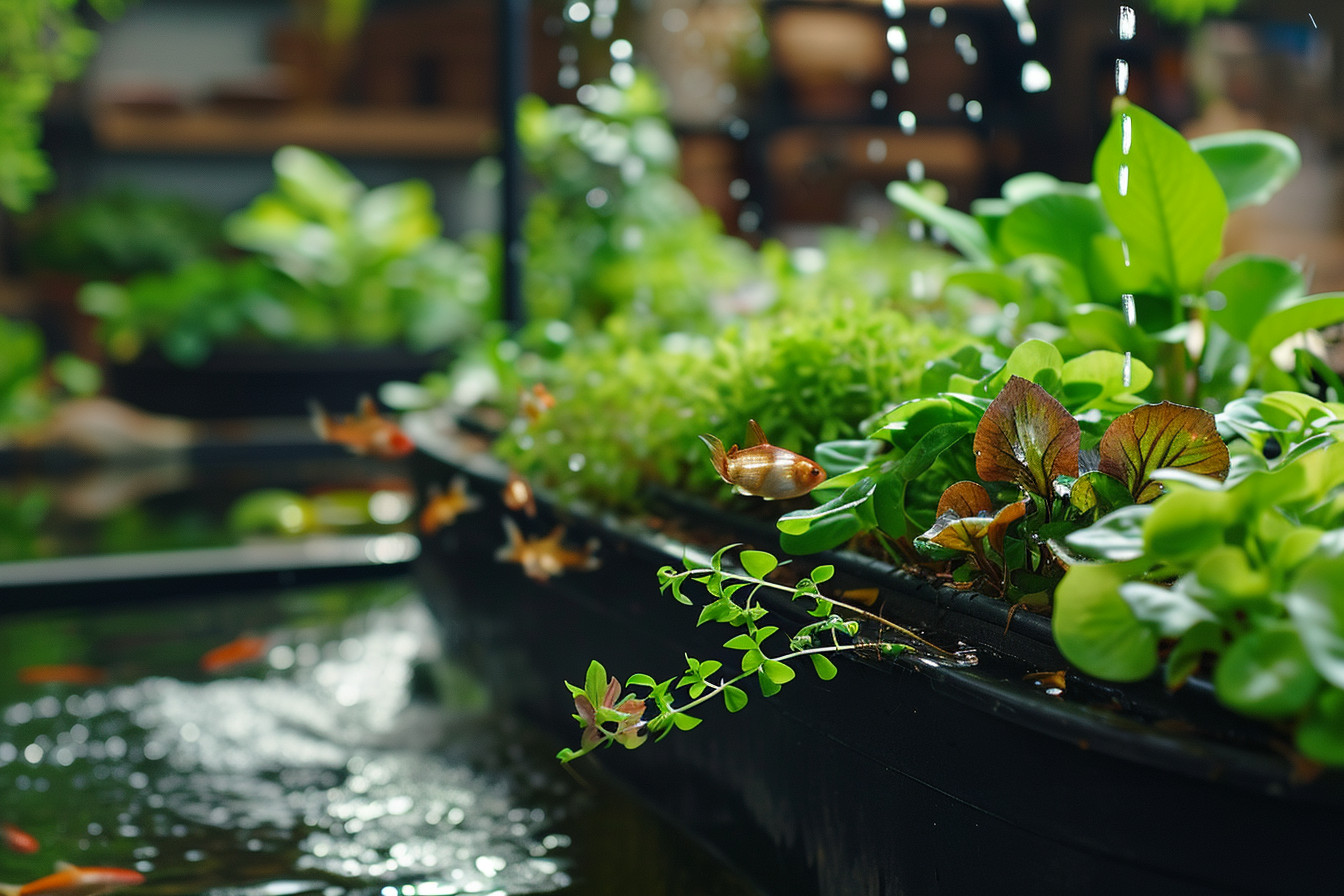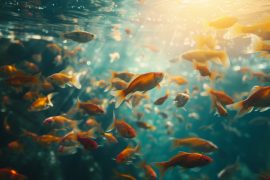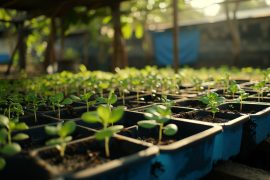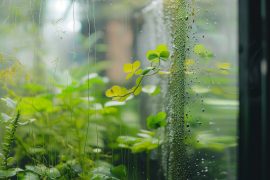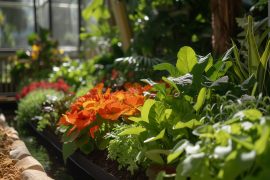Ever thought you’d need a sprawling backyard to get your gardening game on? Think again! Aquaponic gardening is flipping the script, letting you grow lush greens and raise fish together, even in the tiniest of spaces. It’s like hitting two birds with one stone, or should I say, feeding two mouths with one veggie?
I’ve been digging into the world of aquaponics and, let me tell you, it’s a game-changer for us urban dwellers with space as limited as a studio apartment. It’s peaceful, it’s harmonious, and it connects you with nature in ways you wouldn’t expect from a few square feet.
Benefits of Aquaponic Gardening in Small Spaces
When I first stumbled upon aquaponic gardening, I was on the hunt for a way to bring a slice of serenity into my cramped city apartment. The beauty of aquaponics is that it allows city dwellers like me to foster a connection with nature that’s undemanding of space yet abundant in yield.
Aquaponics marries aquaculture and hydroponics in a symbiotic environment, where fish waste provides organic food for plants, and plants naturally filter the water for the fish. It’s fascinating, really, and the benefits are numerous, especially when space is at a premium.
Creating a tranquil oasis amidst the hustle and bustle of urban living is a real possibility with aquaponic gardening. The gentle murmur of water and the verdant greenery offer a peaceful escape; it’s my little zen corner where I can relax and breathe deep. It’s not just an aesthetic delight, though; there’s a robust science backing the efficiency of this method.
Aquaponics systems require considerably less water than traditional soil gardens, an important factor for sustainability. Water is continuously recycled through the system, so water efficiency is maximized. For those of us fretting over utility bills, this is a welcome relief. Here’s a quick comparison to illustrate the difference:
| Gardening Method | Water Usage |
|---|---|
| Traditional Soil | High Water Consumption |
| Aquaponics | Reduced Water Usage |
Another perk of small space aquaponics is the reduction in labor. I’ve waved goodbye to the arduous tasks of weeding, tilling, and soil maintenance. There’s no need for those back-breaking gardening chores anymore.
You might wonder about the potential harvest from such a compact system. Let me tell you, the yield is impressive. Plants tend to grow faster because they have constant access to the nutrients they need. I’ve harvested leafy greens, herbs, and even tomatoes much quicker than I ever could with conventional gardening.
For those intrigued by the technicalities, aquaponics systems can be quite accessible, even for beginners. I’ve broken down complex concepts into simple, actionable advice in my past writings, and many people I know have successfully set up their own systems with minimal prior experience. The educational journey is rewarding, rife with Aha! moments as the cycle of life unfolds before your eyes.
Choosing the Right System for Your Space
When I first dipped my toes into the world of aquaponic gardening, I realized that picking out the right setup was crucial. My tiny apartment didn’t have much room to spare, so I needed a system that fit just right. Here’s what I learned about selecting an aquaponic system for a small space.
Space Considerations
First off, take a good look at your available space. Are we talking about a windowsill, a balcony, or maybe a corner in your kitchen? Measure this area. I’ve seen folks overlook this step only to bring home a system that’s either too big or so small it barely grows a sprout.
System Types
Aquaponic systems come in all shapes and sizes, from the compact tabletop kind to larger setups that could cover a whole wall. Here are a few common types:
- Media-Based Systems: Ideal for beginners and believe me, they’re pretty forgiving. The grow media, often clay pebbles, supports the plants while the fish live below. It’s a simple setup and a great entry point.
- Nutrient Film Technique (NFT): Better for those with a bit more experience. Plants grow within channels where nutrient-rich water flows over their roots. It’s sleek but needs a bit more know-how to handle.
- Deep Water Culture (DWC): This is for the enthusiast who’s ready to take their aquaponic journey to new depths. Your plants float on top with roots submerged in water. It’s efficient and can be scaled up.
Light and Environment
Lighting isn’t just about helping your plants grow; it’s also about setting a tranquil mood. Opt for LED grow lights if you’re short on natural light—they’re energy-efficient and don’t take up much space. Ensure that the area you pick maintains a stable environment, as drastic temperature changes can throw a wrench into your peaceful garden sanctuary.
Budget
While dreaming big is part of the fun, staying grounded with a budget is essential. I started small, choosing a compact system that didn’t break the bank. As my thumb turned greener, I gradually invested more into my setup. Remember, sometimes bigger isn’t better. It’s about finding harmony between your space, budget, and commitment.
Maintenance
Setting Up Your Aquaponic Garden
When I first started my aquaponic garden journey, the peacefulness of cultivating plants and fish together struck a chord within me. There’s something incredibly harmonious about creating a tiny ecosystem in your own space. It’s like you become part of a small, thriving universe that’s all connected.
Choosing the right spot is crucial. You’ll want to find a balance between direct sunlight and shaded areas, since too much heat can harm your fish and plants. I often recommend north-facing areas if you’re in the northern hemisphere—they usually provide a consistent level of light without the harsh midday sun.
Setting up your system begins with cycling. For those unfamiliar, cycling is the process where beneficial bacteria build up to convert fish waste into plant-friendly nutrients. It’s a technical term, but think of it as the warm-up lap before the race starts; nothing performs well without it.
Assembling your aquaponic system might feel daunting, but it’s quite satisfying once you get the hang of it. You can start with a small, ready-made kit, which can be perfect for learning the ropes. If you’re up for a challenge, DIY setups can be tailored to your space. I’ve used everything from old bathtubs to window boxes, and believe me, the possibilities are endless.
Don’t forget about the water pump and aeration system—your fish need oxygen, and the plants need nutrient-rich water circulated. I learned early on that a quiet, efficient pump is worth the investment for the serenity it maintains in my garden space.
Speaking of investments, I’m often asked about the cost efficiency of aquaponic systems. While setting up an aquaponic garden can have upfront costs, the savings on produce and fish, over time, make up for it. Plus, you have the added benefit of knowing exactly where your food comes from—a priceless piece of mind in my book.
Let’s talk plants and fish. Leafy greens like lettuce, basil, and kale thrive in aquaponic gardens, and they’re a joy to pluck fresh for an impromptu salad. As for fish, tilapia and goldfish have been my go-to choices due to their hardiness and adaptability.
Choosing the Right Fish and Plants
In aquaponic gardening harmony between your fish and plants isn’t just a lofty goal; it’s essential. I’ve always been captivated by the symbiosis in these systems – how fish provide nutrients for the plants, and in turn, the plants clean the water for the fish. Think of it as a peaceful back and forth that keeps both parties thriving.
First, let’s chat about the fish. You want species that are hardy and can handle variations in water conditions, especially since small-scale systems can fluctuate more than large ones. Goldfish and Betta are excellent starter fish because they’re not too fussy. If you’re looking for something that’s more than just a pretty swimmer, Tilapia or Bass might be your game. They’re edible and grow quickly, but keep in mind local regulations about raising them.
Plants. They’re not just the green decor; they’re the lifeline of your system. Leafy greens like lettuce, kale, and spinach are superstars in aquaponics because they grow rapidly and don’t need much maintenance. If you’re feeling adventurous, why not try some herbs? Basil, mint, and cilantro can do wonders, making your space smell like a fresh garden.
| Fish | Water Condition Tolerance | Growth Rate |
|---|---|---|
| Goldfish | High | Moderate |
| Betta | High | Slow |
| Tilapia | Moderate | Fast |
| Bass | Moderate | Fast |
| Plants | Growth Rate | Maintenance Level |
|---|---|---|
| Lettuce | Fast | Low |
| Kale | Fast | Low |
| Spinach | Fast | Low |
| Herbs (Basil, Mint, Cilantro) | Moderate | Moderate |
I remember setting up my first aquaponic system – I was struck by the fragile balance it needed. It taught me patience and gave me a crash course in evaluating compatibility. For instance, heavy feeders like tomatoes can be part of your setup, but they’ll need more fish to supply their nutrient demands. Look at your fish load and decide if you’re up for more feedings and possibly a larger tank.
Maintaining Your Aquaponic Garden
Every day, I step into my aquaponic garden and I’m greeted by a sense of tranquility that only the harmonious dance of fish and plants can provide. It’s not just about growing food—it’s about cultivating life and balance, rekindling that connection with nature right in my living room. Now, I want to help you maintain that little slice of serene productivity.
Weekly Water Tests are a must. I keep tabs on pH, ammonia, nitrite, and nitrate levels. Trust me, the few minutes spent on testing can save you from losing your leafy friends and finned buddies down the road. Adjustments might be necessary, and that’s okay. Just like us, the aquaponic system needs a balanced diet.
Don’t forget about Fish Health. I like to watch my fish for a bit each day; it’s calming and gives me a chance to spot any unusual behavior or signs of disease. Early detection can be the difference between a simple treatment and a full-scale emergency.
Then there’s the Plant Care. I’ve learned that plants speak to you in their own way. Yellow leaves? They might need more nutrients. Stunted growth? Check your light levels. In aquaponics, it’s all interconnected. You get a feel for what’s off and how to fix it.
Let’s break down some maintenance essentials:
- Monitor water levels: Evaporation happens, more in some climates than others. Topping it off is a simple fix.
- Prune your plants: It encourages growth and maintains airflow, reducing the risk of disease.
- Feeding your fish: They’re the engine of the system! Too much food and you’ll cloud the water, too little and they won’t power your plants. Find the sweet spot.
As for balancing plant nutrition, well, that’s a bit like being a gourmet chef. Each plant has its preferred menu. Iron, Calcium, and Potassium supplements might come into play, especially for those heavy feeders like tomatoes I mentioned earlier.
Final Thought
So there you have it! With a little bit of care and attention aquaponic gardening can thrive even in the tiniest of spaces. Remember to keep an eye on your water quality and your fish pals while giving your plants the TLC they need. Trust me it’s worth the effort when you see your little ecosystem flourishing. Whether you’re growing herbs for your kitchen or flowers for your soul aquaponics is a rewarding way to garden. Now go on and give it a try—I’m rooting for you and your green thumb!
